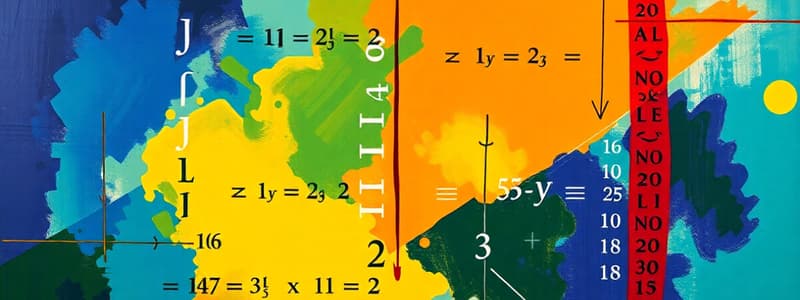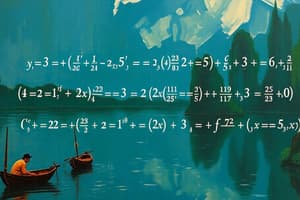Podcast
Questions and Answers
What is the main difference between an expression and an equation in algebra?
What is the main difference between an expression and an equation in algebra?
An expression does not have an equal sign and represents a value, while an equation asserts equality between two expressions.
Define a linear equation and give an example.
Define a linear equation and give an example.
A linear equation is an equation of the first degree, typically in the form y = mx + b; for example, y = 2x + 3.
What is factoring in algebra and why is it useful?
What is factoring in algebra and why is it useful?
Factoring is expressing a polynomial as a product of its factors, which is useful for simplifying expressions and solving equations.
How do you graph a system of equations?
How do you graph a system of equations?
Explain what a function is and provide an example.
Explain what a function is and provide an example.
What is the significance of exponents in algebra?
What is the significance of exponents in algebra?
Describe the relationship between inequalities and their graphical representation.
Describe the relationship between inequalities and their graphical representation.
What are common algebraic identities and their role in algebra?
What are common algebraic identities and their role in algebra?
Flashcards are hidden until you start studying
Study Notes
Algebra
-
Definition: The branch of mathematics dealing with symbols and the rules for manipulating those symbols; it represents numbers and relationships.
-
Basic Operations:
- Addition (+)
- Subtraction (−)
- Multiplication (×)
- Division (÷)
-
Variables: Symbols (usually letters) used to represent numbers in equations and expressions (e.g., x, y).
-
Expressions:
- Combinations of numbers, variables, and operations (e.g., 3x + 5).
- No equal sign present.
-
Equations:
- Mathematical statements asserting equality between two expressions (e.g., 2x + 3 = 7).
- Solutions are values of variables that make the equation true.
-
Types of Equations:
- Linear Equations: Equations of the first degree (e.g., y = mx + b).
- Quadratic Equations: Equations of the second degree (e.g., ax² + bx + c = 0).
- Polynomial Equations: Equations involving a polynomial expression.
-
Factoring: Expressing a polynomial as a product of its factors (e.g., x² - 9 = (x - 3)(x + 3)).
-
Functions:
- A relation that assigns exactly one output for each input (e.g., f(x) = x²).
- Notation: f(x) denotes the function value at x.
-
Graphing:
- Visual representation of equations on a coordinate plane.
- Key concepts include slopes, intercepts, and shapes of graphs (e.g., lines, parabolas).
-
Systems of Equations:
- Set of equations with the same variables (e.g.,
- 2x + 3y = 6
- x - y = 2).
- Solutions can be found using substitution, elimination, or graphing.
- Set of equations with the same variables (e.g.,
-
Inequalities:
- Expressions that show the relationship between quantities that are not equal (e.g., x + 2 > 5).
- Can be represented graphically.
-
Exponents and Radicals:
- Exponents represent repeated multiplication (e.g., x^n).
- Radicals express the root of a number (e.g., √x).
-
Common Algebraic Identities:
- (a + b)² = a² + 2ab + b²
- (a - b)² = a² - 2ab + b²
- a² - b² = (a + b)(a - b)
-
Applications:
- Used to solve real-world problems, model relationships, and analyze data.
- Foundational for higher mathematics, including calculus and statistics.
Algebra Overview
- A mathematical branch focused on symbols and rules for manipulating them, representing numbers and relationships.
Basic Operations
- Operations include addition (+), subtraction (−), multiplication (×), and division (÷).
Variables
- Symbols, often letters like x and y, represent numbers in mathematical expressions and equations.
Expressions vs. Equations
- Expressions: Combinations of numbers, variables, and operations without an equal sign (e.g., 3x + 5).
- Equations: Mathematical statements indicating equality between two expressions (e.g., 2x + 3 = 7), solved by finding variable values that satisfy the equation.
Types of Equations
- Linear Equations: First-degree equations typically represented as y = mx + b.
- Quadratic Equations: Second-degree equations expressed as ax² + bx + c = 0.
- Polynomial Equations: Involve polynomial expressions.
Factoring
- The process of expressing polynomials as products of their factors, such as x² - 9 = (x - 3)(x + 3).
Functions
- A function relates each input uniquely to one output (e.g., f(x) = x²), with f(x) denoting the output value for input x.
Graphing
- Represents equations visually on the coordinate plane, illustrating slopes, intercepts, and graph shapes like lines and parabolas.
Systems of Equations
- Consist of multiple equations sharing the same variables (e.g.,
- 2x + 3y = 6
- x - y = 2).
- Solutions determined by methods such as substitution, elimination, or graphical representation.
Inequalities
- Expressions indicating a non-equal relationship between quantities (e.g., x + 2 > 5), which can also be represented graphically.
Exponents and Radicals
- Exponents express repeated multiplication (e.g., x^n).
- Radicals represent roots of numbers, illustrated by the square root notation (e.g., √x).
Common Algebraic Identities
- Useful formulas include:
- (a + b)² = a² + 2ab + b²
- (a - b)² = a² - 2ab + b²
- a² - b² = (a + b)(a - b)
Applications of Algebra
- Essential for solving real-world problems, modeling relationships, and data analysis.
- Provides foundational concepts for advanced mathematics, including calculus and statistics.
Studying That Suits You
Use AI to generate personalized quizzes and flashcards to suit your learning preferences.



